Main page DonNTU
Page of masters DonNTU
Seaech sistem of DonNTU
Main page
Russian language
MASTER'S DISSERTATION
Dorozhkina Inna Nikolaevna
Theme of masters dissertation:
"Structural and parametric providing of assembling assembling of screw-threads connections on machines rotor type"
Scientific leader:Vodolazskaya N.V.
faculty: mechanical
1 INTRODUCTORY PART
Efficiency of creation of producible machines depends on the level of preparation of assembling of production. Now takes place to the tendency of relative increase expenses of labors on assembling. It is accounted for it by the certain features of technology of assembling processes labour intensity to which in an engineer, does on the average 20-50% from labour intensity of creation of wares, taking second seat after the set of tools [1,2].
Perfection the processes of automation assembling, which promote to multiplying the labour productivity, to diminishing of labour intensity of production and cutting prime costs products of main task.
Systems approach to perfection processes of automation assembling stipulated a necessity, to pay most intent attention on collection details, optimization of technological process of assembling and to make reliable development, capable in working, collecting the equipment [3].
Reality of theme. Technological process of the automatic assembling has differenced the technological process of hand and mechanized, assembling. In hand, assembling it is necessary to have simplest instruments (wrench, screwdriver and etc.), and in the automatic assembling of those things is the difficult complex of automatic devices is needed, executing all transitions of assembling. In this connection the special reality is purchased by the questions of creation of equipment providing the shortest high-quality assembling of wares. In the decision of this task by perspective direction there are the industrial productions of wide introduction of the technological systems of continuous action executable on the base of automats of rotors and automatic transfer lines of rotors.
However much intensive development of machines of rotors and automatic transfer lines, replacing in a number of productions, existing before the equipment and regions of productions and labour force in 4-5 times providing reduction, began in 50, and duration of cycle of production and duration of production cycle in hundreds of volume one the times.
There were created lines of rotors, high -effected for creation of plastic details pressing and leading, detail of chains of ride and their assembling, for the chemical sources of stream, knots of devices of semiconductors, details to bearing of roll and etc.
The machines of rotors in all their efficiency is the initial stage of development of the machines characterized by continuous motion of the articles of treatment only, and it is the so-called machines conveyers for a rotor a difference to which from rotors consists of dissociating of instrument from the executive branches of machines is their developed form [4] .
The first standards of lines conveyers for a rotor confirmed that span-new economic indexes are incident to them.
Every assembling process is examined as unity and intercommunication of three components of automation, technological process and facilities, providing the performance of the placed objective. As facilities the automatic systems of rotors were select. One of directions of their improvement is the use of two principles of compactness and functionally oriented structure and agreements of rotors, collecting the machines developed on the basis of these principles. Absence of the stage of creation of pre-production model is the feature of equipment of rotor for verification of decisions of agreements. Therefore in creation of automatic collecting rotor of the systems a type is purchased by large development of value of algorithms and designing method.
Because objective automations were select connections of screw-threads as widest widespread type of sectional connections, meeting in all wares of industry. The decline of labors intensity of assembling of connections of screw-threads is other argument in the question of choice relatively other types of works. Reality of choice by the object of automation of connections of screw-threads confirms a circumstance that, devoted automation of assembling of processes among the great number of works, the questions of automation of assembling of connections of screw-threads found the insufficient reflection for a number of reasons: from the variety of buildings of connections of screw-threads, complication of orientation and, founding and tp. There are problems requiring the working-outs, namely: systems approach is absent to the analysis and synthesis of process of the automated assembling of connections of screw-threads, collecting, influencing on a process, on a possible result, and also, to create the generalized models and algorithms, describing all process and separate his electors.
An actual scientific task for assembling of connections of screw-threads conducts structural functional researches of the automatic systems of rotors and creation on the basis of their synthesis of variants of compact structure extraordinarily effective technological systems.
The purpose of master’s work is increase efficiency and quality of assembling of connections of screw-threads print on the rotor of machines, on the basis of development structural and parametrical providing.
A research object is the process of planning of assembling of equipment of machines for assembling of wares of screw-threads.
The article of research is the aggregate of procedures of projects of development agreement of machines for assembling of screw-threads.
Research methods. For research of process of planning of agreements of machines of rotors for assembling of wares of screw-threads methods of systems analysis, theory of the difficult systems, mathematical logic was used. In foundation of researches of transitions of assembling of wares of screw-threads in the choice of agreement of rotor sanforize the technological methods of differentiation and concentration of actions corrected. The methods of making technical decisions are used for formed of rational sequence of the automated synthesis of principle agreement.
1. Classification of screw-threads wares at first develops from position of automation of assembling process, allowing to set the limits of assembling applied from kinds.
2. Description of technological process of assembling of screw-threads wares executable on the machines of rotors.
3. For the process of the automated planning of the system collecting for a rotor the complex of mathematical models and algorithms of realization these procedures, which take into account basic technological designers and economic factors, influencing on the productivity of the system, develops at first.
Practical value of the got results. The developed methods of synthesis allow to design the concrete variants of the automatic systems of rotors, providing the high performance of assembling of wares of screw-threads, compactness of the collecting system in the space and functional orientation of his structure. On the basis of the developed researches complex methodical, informing and programmatic providing of process of planning of agreements of machines of rotors arranged for assembling of connections of screw threads.
Actuality of choice of object automation of connections of screw-threads confirms a circumstance that among, that the great number of the works devoted to the questions of automation assembling of processes, there are any of scientists: Arpent'eva B.M., Zenkyna A.S. [1,5], Gelfand M.L., Tsypenyuk U.I. [6,7,8,9,], Zhabyn A.I., Martynov A.P. [2,10], Zakharov N.V., Tymofeev U.V. [11], Koshkin L.N., Klusov I.A., Preys V.V. [12,13,14,15,16], Korsakov V.S. [17,18], Kosylov V.V. [19,20], Lebedovsky M.S. [21,22,23,24], Mykhaylov A.N., Ternyuk N. E. [25,26,27], Novykov N. P. [28] and etc.
The questions of automation assembling connections of screw-threads found the insufficient reflection to subsequent reasons: variety in buildings of screw-threads and elements which tailed to; complication of orientation and basing connections of screw-threads; blowing off the first screw-thread’s rings in when to wind, necessity in fixing; complications of portage of knot of screw-thread.
Mainly attention was spared to the calculations of loadings on connections of screw-threads [5,29]. Analytical dependences for the calculations of twisting moments [30], and different buildings of screwing up thread devices [7,8,9,31] which can be used only for little mechanization of assembling actions. Although in works of Yakymovych V.A., Golovaschenko V.E., Kulynych V.Y.[32], and by other vast material presented through question of the automated assembling of connections of screw-threads, there is a number of problems requiring the working-outs.
2 BASIC PART
2.1 STATE OF THE ART REVIEW OF THE MODERN STATE OF RESEARCH QUESTION
2.1.1 THE ANALYS OF PROCESS AUTOMATION ASSEMBLING OF GOOD «VALVE of AV-013М» AND LABOUR INTENSIVENESS OF ASSEMBLING WORKS
Assembling of wares is the finishing stage of production process which that a man clashed yet in the period of creation of the first tools. Assembling processes, in the process of evolution became complicated and was perfected. Researchers select three stages of history of assembling presented on a picture 1:
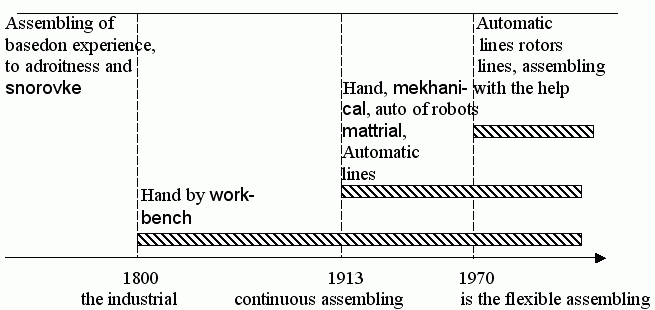
Picture 1 – Evolution of assembling [18]
These stages are associate and inalienable between itself. Assembling – it is part of technological process of making good which end with work on connection of separate details in knots and arrangements last for giving to good of the prepared kind in accordance with his functional setting [18, 33, 34, 35].
Analyze of the most interesting events, related to the assembling production [36, 37] show that the first attempts of automation assembling works were undertaken at the end of a 18 century (1784), further development of automation happened at the beginning of a 20-th century (1903-1913 y.) and in 30th with appearance of rotors assembling machines. But for much theoretical bases of their application for most assembling operations do not exist for a present time. For development of such bases it is necessary to explore general descriptions, labour intensiveness of assembling process. In the machine-building the labour intensiveness of assembling works makes 20-70% [33, 35, 37] from labour intensiveness of making of wares, taking second seat after tooling. Expenses of labour on assembling is presently increased.
Such position is explained by the problems of economic development of Ukraine, and also specific features of mechanization and automation of assembling processes. Effective by the decline of labour intensiveness of assembling works for the mass and large-serial production there is application of the technological rigging on the basis of aggregating of assembling equipment [37, 38]. Using this principle, from the comparatively limited number of details it is make enables to create the most various assembling adaptations.
Thus, the type of production has deciding influence on technology and organization of assembling works, for development of technological processes [33, 34, 35]. In dependence from expenses of time on assembling works from production’s type (in percents from general labour intensiveness of making of machines)presented on a picture 2 :



Picture 2 – Diagram of distributing intensiveness of labour on the types of production [33]
Basic part of assembling works, in the conditions of single and finely-mass types of productions, is executed on general assembling, only a small stake is carried out under separate assembling units. With multiplying mass-produced assembling works are all anymore broken to pieces on separate assembling units, and in the conditions of mass and large-series types of productions of the key assembling to become equal or even excels the volume of the general assembling, that is instrumental in mechanization and automation of assembling works.
Basic part (50-85%) [2, 37] of metalwork-assembling works is the handworks requiring the heavy tolls of manual labour of high qualification of workers.
It is special characteristic for the terms of single and finely-mass production, stake of products of which in general, volume of output of machine-building wares most, and the level of mechanization of metalwork-assembling works is very low.
In the single and finely-mass production the specific of machines assembling is characterized, by difficulties of mechanization and automation from the frequent changing of nomenclature of wares, and it requires application widely of universal technological facilities, at their application on the concrete technological operations the small percent of their technological and economic feasibilities will be realized only. As a result of certain unforeseeableness (in the conditions of market economy) of nomenclature of details an enterprise is forced to have the surplus technological resources some part of which can appear unclaimed kit notoriously. Thus, the necessity of details making of wide nomenclature forces an enterprise to have the large variety of technological facilities [17]. In the number of problems is insufficient specialization, low level of standardization and standardization, small studied of processes also, that results in low collection of assembling units to the phenomenon, when assembling is accompanied by the very considerable volume of fitting-completing works the labour of intensiveness of which exceeds labour intensiveness assembling operations.
Folded assembling process in single and finely-mass production it is expedient to present on the basis of grouping on the kinds of works[2]:
1. metalwork completing works (cleaning of shaving, boring of openings, cutting of screw-thread and etc.);
2. of fitting-completing works (fitting of surfaces, unforeseen by the technological process of assembling, and also «normal» of fitting-completing operations, foreseen TC on assembling;
3. metalwork-auxiliary works (making of gaskets, springs, pucks and other details);
4. balancing of details and assembling units;
5. actually-assembling works;
6. rolling and test of assembling units and wares;
7. sorting out and dismantling of good;
8. preservation and packing.
On integrity’s saving of assembling of connection is subdivided into sectional and unsectional [33, 34, 35, 39]. The amount of sectional connections in modern machines and mechanisms is 65-85% of all connections. For the common machine-building the number of connections of the indicated kinds can be selected by correlation 0,45:0,35:0,15:<0,05(picture 3).
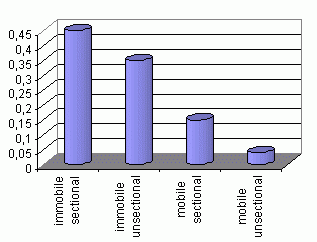
Picture 3 – Correlation of types of assembling connections [33]
On a form the attended surfaces connections subdivide on:
cylindrical;
flat;
combined;
conical;
spherical;
screws;
types.
It is shown on a picture 4 :
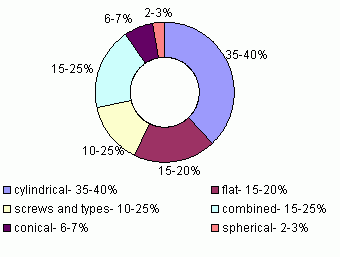
Picture 4 – Classification of connections on a form the attended surfaces [33, 39]
From point of automation it is possible to examine every assembling process as unity and intercommunication of three parts: objects of automation, technological process and facilities, providing the performance of the put objective.
As an object of automations were chosen screw-threads connections, because they are the most widespread type of sectional connections [2, 32, 40] and meet practically in all wares of machine building, shipbuilding, motor industry, and other regions of industry. It follows also and from the above-enumerated classifications from which, evidently, that sectional immobile connections the representatives of which there are screw-threads connections make 45% (picture 1.3).
Another by an argument in the question of choice the necessity of decline of labour intensiveness of assembling of screw-threads connections can serve in relation to other types of connections [41]. Correlation of types of connections on labour intensiveness presented on picture 1.5.
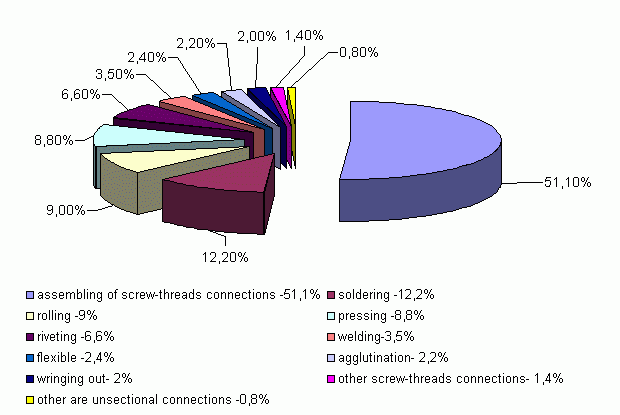
Picture 5 – Correlation of types of connections on labour intensiveness
Through question of the automated assembling of screw-threads connections there is a number of problems requiring the working-outs, namely: to the present tense systems approach is absent to the analysis and synthesis of process of the automated assembling of screw-threads connections. Which would allow to see the various groups of factors, assembling influencing on a process, take into account their changes and intercommunication in different situations and influence on an eventual result, and also to create the generalized models describing all process and separate his constituents.
It is necessary for the decision of these questions, foremost, to conduct the analysis of methods of assembling of screw-threads connections.
2.1.2 ANALYSIS OF SCREW THREADS CONNECTIONS ENTERING IN THE COMPLEMENT OF ASSEMBLING UNIT
«VALVE OF AV-013М»
At assembling of screw-thread connection a detail is a basic element “Corps”, which is the element of valve AV-013М hand intended for setting to pneumatic wide, workings on air, helium, nitrogen and argon. He is intended for fastening on him of details of valve and joining directly to the network, and is the basic element of valve.
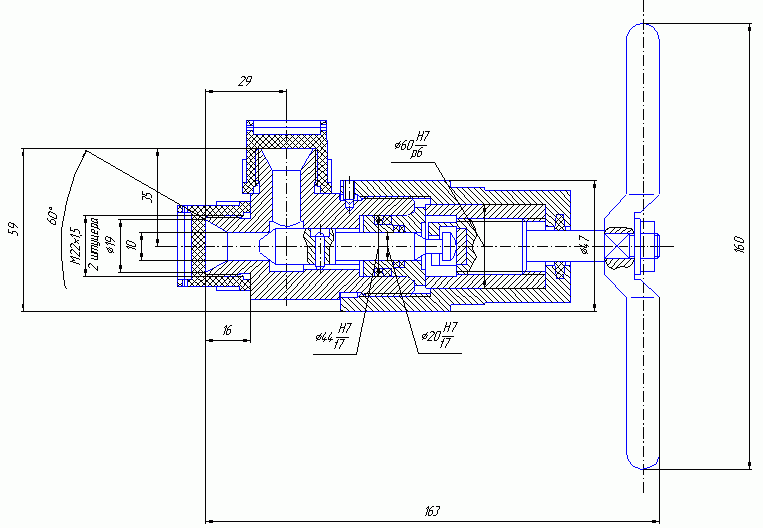
Picture 6 – Valve of AV-013М
A valve has the followings descriptions hand: pressure of working environment 40 MPa, temperature range of capacity ± 50°, conditional communicating diameter of 10mm, overall sizes 163x160x47 mm.
Chart of connection entering in the complement of assembling unit shown on a picture 7.
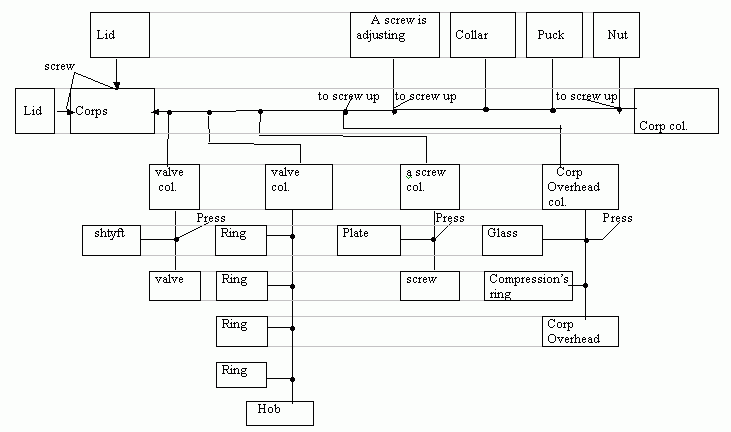
Picture 7 – Chart of connections entered in the complement of assembling unit "Valve of AV-013М"
In screw-thread connection all details are divided on two groups: connected and connecting. In assembling unit one of details is bearing: other register to her. The corps of valve is a bearing detail. The therefore connected details are divided into basic (base) and joinings (stuffs) [32]. Those details, which, possessing large mass and sizes, stay usually still in the process of assembling and are passive, behave to the base details. Exactly to them join the other details. Base details unite all other in one assembling unit or good. To them behave: valve, hob, screw, a corps is overhead.
Connection of screw-threads details is made from different directions and under different corners. In particular, it is carried out along a horizontal line (on the right, on the left, at the front or behind), and also under different corners to the vertical line and horizontal line [6,32,37, 38, 39].
Different details formative connection, at the automatic assembling behave differently [18, 32, 39]. About their capacity for realization of this process it is possible to judge on such signs:
possibility of orientation of the joined detail;
possibility of serve, fixing and basing of that detail;
condition of co-operation of the joined detail with the executive mechanism of automat.
Stuffs details is characterized that they are screwed into in base details or is screwed on them. As a rule, the role of stuffs details at assembling is active, because exactly they accomplish necessary motions rotation and forward moving. To them behaves:
shtift;
lid;
ring;
compression’s ring;
plate;
glass;
adjutant’s screw;
collar;
puck;
nut.
For assembling of screw-threads connections the different types of devices which include the followings groups are used:
1)loads – serve for the accumulation and moving in space of the collected objects (trays, bunkers and other);
2)adjusting – serve for the correct mutual setting of base and joinings objects with the required exactness and fixing in the required position;
3)orienting – intended for giving to the objects of assembling required position in space;
4)workers – serve for implementation of concrete connections (baiting, wrapping, preliminary and final inhaling and fixing);
5)controls – serve for verification of moment of inhaling and other to the required indexes of quality (tent-beds tests, devices for the control and other);
6)combined – connect in itself two and more of the types of adaptations considered higher (vibration-bunker with the built-in orienting device and etc.).
For the mechanized and automated assembling of screw-threads connections the various types of nut-screwier, cartridges of screw-thread heads, semi-automatic devices and automats, the constructions of which choose depending on a method assembling the basic varieties of which can be presented by a next chart (pic. 8).
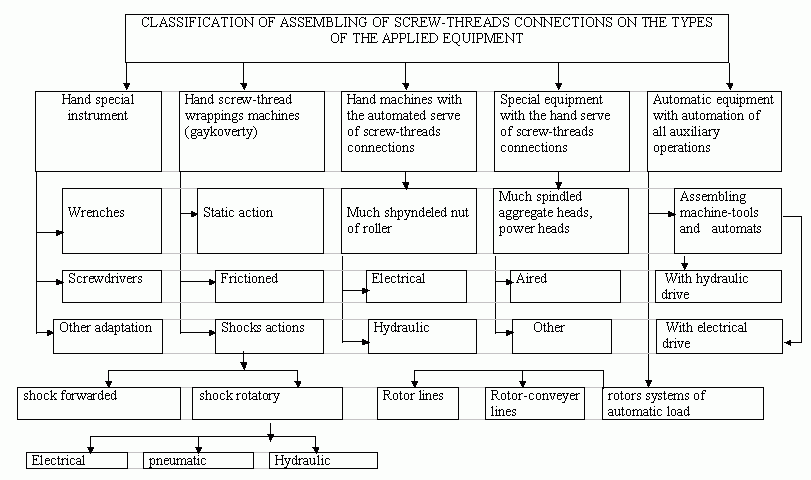
Picture 8 – Chart of basic varieties of assembling's methods screw-threads connections
From plenty enough of the presented methods of assembling we will select such only, which possess advantages, to do them especially rational and effective for the mass production, namely, methods of assembling by the automated and automatic systems.
2.2 GENERAL PART
2.2.1 ANALYSIS OF TECHNOLOGICALNESS
Detail a corps behaves to the class of prismatic details. It is made from steel of 12X18H10T GOST4543-71, which has the following chemical composition: C=0.12%, Cr=18%, Ni=10%, T=1%, S=0.02%, P=0.035%. This steel behaves to the constructions heatproof steels and is such physical-mechanical characteristics: sв =530MPa, sr =236MPa, it is satisfactorily processed by cutting.
On the draft of detail there are all kinds, sections and cuts, necessary for presentation of construction of detail. Sizes are filled in with the rejections, the parameters of roughness correspond to exactness of surfaces. Admittances of form and location of surfaces are grounded enough and does not cause difficulties at their achievement (the tied surfaces up are processed on one setting). It isn’t present superfluous elements in the construction of this detail.
The construction of detail allows to conduct treatment, both on the universal equipment and on specialized. Treatment of detail is possible with the use of universal and special cutting and control instrument, access of which to the processed surfaces free. On a detail all elements are technological, except for opening, as openings is on a cylindrical surface. Surfaces of Ф13H8 and Ф22H8 are the most exact surfaces. We get them by boring, zenkering and development. Surfaces screw-threads М36х2-6g and М22х1,5-6g we get the double sharpening, and we cut a screw-thread by a chisel. Square 38h12х38h12 we get milling on a horizontally-milling machine with the use of the special milling cutter.
A detail is hard and it does not limit the choice of the cutting modes. There is no sense to replace to its combined team.
All surfaces of detail are accessible and does not cause difficulties in treatment.
Requirements on the radial beating of 0,05mm it is possible to provide at treatment the purveyances in a three-fist cartridge
In spite of the indicated failings, a detail is technological.
2.2.2 DETERMINATION AS PRODUCTION
On the set annual program of issue of details Nг=100000 p./y and to factories information on labour intensiveness of making of detail determined:
Type of production [42]:
Time of issue of details:

where: Fd – is the actual annual fund of time during two-shift work,
Fd =3890 hours
D – is the annual program of issue of details, D=100000
r=1,9 min.
k=0,8 is correction coefficient.
Coefficient of serialness [42]:

where: tшс=3,25 minutes is mean piece time of making of detail from data of factory technological process.
Кс =0,57, that corresponds to the mass type of production.
2.2 CHOICE OF METHOD OF RECEIPT OF PURVEYANCE
At the choice of purveyance for the set detail we appoint the method of its receipt, determine configuration, sizes, admittances and pripusk on treatment and make the technical requirements produced to the purveyance.
For the receipt of purveyance there are some methods are possible: casting, forging, stamping, cutting of rental.
Forging is not used, as this economic not advantageously, the purveyance will not correspond to necessary configuration.
We do not use casting, as steel of 12Х18Н10Т high-alloy steel which is bad castings characteristics.
The use of rental is limited from the form of detail and low coefficient of the use of metal,

where: Mz – is mass of purveyance,
Md – is mass of detail,

Ким=0.18,
that impermissible in the conditions of mass production.
Application of stamping in the closed stamps beside the purpose, as the purveyance has the complicated configuration. From forging and stamping we adopt stamping in the opened stamps, as this method provides the receipt of more exact purveyance, decline of values of pripusks and increase of coefficient of the use of metal.
As the economic ground we will make an example of calculation of cost of the pressed and cast purveyance.
Cost of the cast purveyance:

where: Ci is the base cost of the 1t founding’s, Ci=9800 of UAH [19] (taking into account the coefficient of inflation );
Q – mass of purveyance, Q=0,66 of kg;
Kt of – coefficient exactness, for founding’s of a 2-d class of exactness of Kt=1.05 [43];
Kc – coefficient of complication, for the purveyances of a 2-d group of complication of Kc=0,9[43];
Kb – coefficient of mass of purveyance, for the purveyance from alloy steel by mass above 20 kg of Kb=0,4 [43];
Km –coefficient of material, for alloy steel of Km=1,93 [43];
Kn – coefficient of serialness, for a 1st group of serialness of Kn=0,5[43];
q – mass of the prepared detail;
S1 is cost of 1 t wastes, S1=750 of UAH
S=114 of UAH
Cost of the pressed purveyance::

where:
Q=0,66 kg;
Kt – coefficient exactness, for normal exactness of Kt=1 [43];
Kc – coefficient of complication, for a 3d degree of complication Kc=1 [43];
Kb – coefficient of mass of purveyance, for the purveyance from alloy steel by mass to 20 kg of Kb=0,75 [43];
Km – coefficient of material, for alloy steel of Km=1,79 [43];
Kn=1 [43].
Sp=407 of UAH.
From calculations evidently, that cost of the pressed purveyance higher of cost of founding, however, material of detail is high-alloy steel which is bad castings characteristics. Casting isn’t applied from the large technological difficulties arising up at his implementation in the conditions of this enterprise.
From all analyzed methods of receipt of purveyance we choose stamping in the opened stamps as the form of purveyance is maximally similar to the prepared detail, that allows considerably to short pripusks on tooling, and taking into account party of issue of these details it is the most productive method.
Calculation of purveyance’s sizes:
1 Calculation mass of stamping [43]:
mp=mд*к,
where: mp – is mass of detail,
k – calculation coefficient, k=1.5,
mp=0,44*1,5=0,66 kg.
2 Group of steel: steel 12Х18Н10Т behaves to the group of M1[43].
3 Mass of figure:
mф=((еП*(1,05*Д)2/4)*1,05*L+1.053*а2*в)*7800,
where: Д – diameter of detail,
L – length of detail,
a – width of square,
в – length of square,
mф=(((3,14*(1,05*0,022)2/4)*1,05*0,016)+((3,14*(1,05*0,022)2/4)*1,05* 0,016))+((3,14*(1,05*0,036)2/4)*1,05* 0,027)+(1,053*0,0382*0,032))*7800=0,775 kg.
4 Degree of complication:
С=mp /mф ,
where:
C – calculation coefficient,
mф – is mass of figure, which a detail is written into, mф = 0,775 kg,
С= 0,66/0,775= 0,85
Determine the degree of complication of C1[43].
5 Class of exactness: we adopt T4 [43].
6 Initial index: is determined: 9 [43].
On fasces, ditches, holes, we appoint slots blacksmiths' napusks. We add findings to the table of 1.1:
Table 1.1 – Determination of sizes of stamping
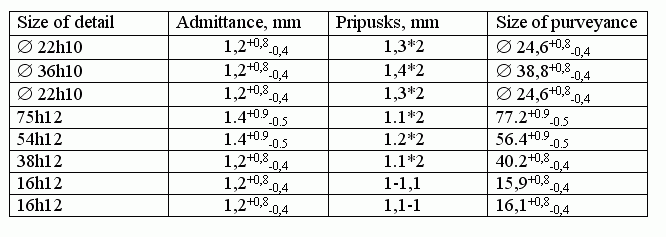
For simplification of stamping form we accept Ф 38,8+0,8-0,4 for a square 40.2+0,8-0,4
3 CONCLUSION
As a result of the conducted researches it is executed:
1. An important folk-economic task consisting of increase of efficiency of rotors machines for assembling of screw-threads wares by arrangements on the base of spatial functional approach is decided;
2. The analysis of screw-threads connections entering in the complement of assembling unit – «Valve of AV-013М is conducted»;
3. The analysis of techno logicalness is made;
4. The method of receipt of purveyance is chosen.
For achieving the put purpose, it is necessary to decide the followings tasks:
to develop of screw-threads details classification from position of degree of automation of assembling process;
to develop the model of screw-thread good assembling is in the automatic loop;
to develop structural model of the systems rotor type for assembling of screw-threads wares is «Valve of AV-013М»;
to develop arrangement model of the systems rotor type for assembling of screw-threads wares is «Valve of AV-013М».
This work is devoted to decision of these basic tasks.
LIST OF REFERENCES
1. Арпентьев Б. И., Земкин А. С., Куцын А. Н. Механизация и автоматизация сборочных работ на машиностроительных предприятиях. – К.: Техника, 1994. – 232 с.
2. Жабин А.П., Мартынов А.П. Сборка изделий в единичном и мелкосерийном производстве. – М.: Машиностроение, 1983. – 184 с.
3. Храбров А.С. Совершенствование процессов автоматизации сборочных работ.- Л.: Машиностроение. Ленинград. отд.-ние. 1979. – 230 с., ил.
4. Кошкин Л.Н. Роторно-конвейерные линии. – 2-е изд. стереотип. – М.: Машиностроение, 1986. – 320 с., ил.
5. Зенкин А. С., Арпентьев Б. М. Сборка неподвижных соединений термическими методами. – М.: Машиностроение, 1987. – 128 с.
6. Гельфанд М. Л., Ципенюк Я. И., Кузнецов О. К. Сборка резьбовых соединений. – М.: Машиностроение, 1978. – 109 с.
7. Гельфанд М. Л. Ручные резьбозавертывающие машины (обзор панентов). – М.: НИИ информации, 1965. – 47 с.
8. Гельфанд М. Л. Исследование резьбозавертывающих машин ударного действия. Диссертация на соискание ученой степени кандидата технических наук. М. 1968. – 139 с.
9. Ципенюк Я. И. Расчет торсионов к гайковертам ударного действия. «Строительные и дорожные машины», 1971, №2, с. 16-17.
10. Мартынов А. П. Исследование и стандартизация методов повышения качества и снижения трудоемкости сборки крупного прокатного оборудования. Диссертация на соискание ученой степени кандидата технических наук. М. 1972. – 135 с.
11. Захаров М. В., Тимофеев Ю. В. Розробка технологічних процесів складання: Навч. посібник. К.: НКМ ВО, 1992. – 152 с.
12. Кошкин Л. Н. Комплексная автоматизация на базе роторных линий. Изд-во 2-е, перераб. и доп. – М.: Машиностроение, 1972. – 351 с.
13. Кошкин Л. Н. Роторные и роторно-конвейерные линии. – М.: Машиностроение, 1982. – 236 с.
14. Клусов И. А. Технологические системы роторных машин. – М.: Машиностроение, 1976 – 231 с.
15. Прейс В. В., Комаров Г. В., Клусов И. А., Маткин Ю. Л., Варьяш Г. М. Автоматическая загрузка роторных и роторно-конвейерных линий. – М.: ВНИИТЭМР., 1990. – 56 с.
16. Прейс В. В. Технологические роторные машины: вчера, сегодня, завтра. – М.: Машиностроение, 1976. – 128 с
17. Корсаков В.С. Основные направления автоматизации сборочных процессов в машиностроении // Автоматизация сборочных процессов в машиностроении. – М.: Наука, 1979. – 9-11с.
18. Сборка и монтаж изделий машиностроения: Справочник: В 2 т. /Ред. совет: В.С. Корсаков (пред.) и др. – М.: Машиностроение, 1983. – Т.1. Сборка изделий машиностроения /Под ред. В.С. Корсакова, В.К. Замятина. 1983. – 480 с.
19. Косилов В. В. Состояние и основные направления технологии сборки в машиностроении //Комплексная механизация и организация сборочного производства на предприятиях тракторного и сельскохозяйственного машиностроения: Тез. докл. Всесоюз. науч.-техн. Совещ. – Павлодар, 1980 – с. 216-218.
20. Косилов В. В. Технологические основы проектирования автоматического сборочного оборудования. М.: Машиностроение,1976. – 248 с.
21. Лебедовский М. С., Вейц В. Л., Федотов А. И. Научные основы автоматизированной сборки. – Л.: Машиностроение, 1985. – 316 с.
22. Лебедовский М. С. Автоматизация сборки изделий. – Л.: СПЗИ, 1980. – 81 с.
23. Лебедовский М. С., Федотов А. И. Автоматизация сборочных работ. – Л.: Лениздат, 1970. – 448 с.
24. Автоматизация сборочных процессов / Лебедовский М. С., Лобзов Б. А., Муценек К. А. и др. Отв. ред. Муценек К. А. Рига: Рижский политехнический институт, 1981. – 81 с.
25. Михайлов А. Н. Разработка методов проектирования высокоэффективных поточно-пространственных технологических систем: Дис. … д-ра техн. наук. – Харьков, 1991. – 498 с.
26. Михайлов А. Н., Тернюк Н. Э. К расчету параметров маршрутизации изделий в поточно-пространственных технологических систем // Известия вузов. Машиностроение, 1990, №11. – С. 63-67.
27. Михайлов А. Н. Основы синтеза поточно-пространственных технологических систем непрерывного действия. – Донецк: ДонНТУ,2002. – 379 с.
28. Новиков М. П. Основы технологии сборки машин и механизмов. 5-е изд. М.: Машиностроение, 1980. – 592 с.
29. Крепежные детали: Справочник/ Под ред. Поливанова П. М. – М.: Машиностроение, 1967. – 247 с.
30. Мухамбетов Г. М. Исследование затяжки ответственных резьбовых соединений и пути обеспечения ее точности в условиях автоматизированной сборки. Диссертация на соискание ученой степени кандидата технических наук. Москва, 1980. – 213 с.
31. Бобриков В. Г. Ударные механизмы, применяемые в пневматических резьбозавертывающих машинах. – М.: ЦНИИТ Эстроймаш, 1971. – 38 с.
32. Яхимович В.А., Головащенко В.Е., Кулинич В.Я. Автоматизация сборки резьбовых соединений. – Львов: Вища школа. Львов. Отд-ние, 1982. – 160 с.
33. Егоров М.Е. и др. Технология машиностроения. Учебник для вузов. – 2-е изд., доп. – М.: Высш. Школа, 1976. – 534 с.
34. Маталин А.А. Технология машиностроения: Учебник для машиностроительных вузов по специальности «Технология машиностроения, металлорежущие станки и инструменты». – Л.: Машиностроение. Ленингр. отд-ние, 1985. – 496 с.
35. Лавриненко М.З. Технология машиностроения и технологические основы автоматизации. – Киев: Вища школа, 1982. – 320 с.
36. Бабушкин М.Н., Кристаль М.Г. Перспективы повышения производительности автоматических сборочных систем. //сборка в машиностроении и приборостроении/Под ред. О.А. Горленко. – Брянск: БГТУ, 2001. – 39 с.
37. Рабинович А.Н. Автоматизация механосборочного производства. – К.: Вища школа, 1969 – 542 с.
38. Белоусов А.П. Дащенко А.И. Основы автоматизации производства в машиностроении: Учебник. – М.: Высш. Школа, 1982. – 351 с.
39. Технология машиностроения: В 2 т. – Т. 1. Основы технологии машиностроения: Учебник для вузов/ В.М. Бурцев, А.С. Васильев, А.М. Дальский и др.; Под ред. А.М. Дальского. – М.: Изд-во МГТУ им. Н.Э. Баумана, 1999. – 564 с.
40. Механизация и автоматизация сборки изделий машиностроения для агро-промышленного комплекса – «Сборка-83»: Тез. докл..– М., 1983. – 148 с.
41. Водолазская Н.В., Михайлов А. Н. Моделирование качества автоматизироаного процесса сборки резьбовых соединений // Сборка в машиностроении и приборостроении: Тез. докл. Междунар. науч.-техн. сем., 2-3 окт.2001 г.. – г. Брянск: БГТУ. – 55-58 с.
42. Методические указания к выполнению курсового проекта по курсу “Технология машиностроения” /Сост.: Н.Г.Бойко, В.А.Богуславський, В.В.Польченко и др., – Донецк ДГТУ , 1995г – 52 с.
43. Справочник технолога машиностроителя. В 2-х т. Т. 1/ Под ред. А.Г.Косиловой и Р.К.Мещерякова. – 4-е изд., перераб. и доп. – М.: Машиностроение, 1985. – 656 с.
Russian language
Upwards
Main page
Main page DonNTU
Page of masters DonNTU
Search system DonNTU

















